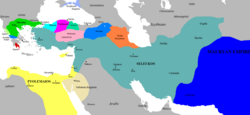
Back Seleukidiese Ryk Afrikaans Seleukiden ALS سلوقيون Arabic امبراطوريه سلوقيه ARZ Imperiu seléucida AST Selevkilər imperiyası Azerbaijani سلوکیلر ایمپیراتورلوغو AZB Селевкиҙар дәүләте Bashkir Дзяржава Селеўкідаў Byelorussian Імпэрыя Сэлеўкідаў BE-X-OLD
Seleucid Empire | |||||||||||||||||||
|---|---|---|---|---|---|---|---|---|---|---|---|---|---|---|---|---|---|---|---|
| 312 BC–63 BC | |||||||||||||||||||
Tetradrachm of Seleucus I, the horned horse, the Elephant and the anchor were all used as symbols of the Seleucid monarchy.[1][2]
| |||||||||||||||||||
 The empire at its greatest extent and on the eve of the death of Seleucus I, 281 BC | |||||||||||||||||||
| Capital | Seleucia (305–240 BC) Antioch (240–63 BC) | ||||||||||||||||||
| Common languages | Greek(official)[3] Persian Aramaic[3] | ||||||||||||||||||
| Religion | Olympianism Babylonian religion[4] Zoroastrianism | ||||||||||||||||||
| Government | Monarchy | ||||||||||||||||||
| Basileus | |||||||||||||||||||
• 305–281 BC | Seleucus I (first) | ||||||||||||||||||
• 65–63 BC | Philip II (last) | ||||||||||||||||||
| Historical era | Hellenistic period | ||||||||||||||||||
| 312 BC | |||||||||||||||||||
| 301 BC | |||||||||||||||||||
| 192–188 BC | |||||||||||||||||||
| 188 BC | |||||||||||||||||||
| 167–160 BC | |||||||||||||||||||
| 63 BC | |||||||||||||||||||
| Area | |||||||||||||||||||
| 301 BC[5] | 3,000,000 km2 (1,200,000 sq mi) | ||||||||||||||||||
| 240 BC[5] | 2,600,000 km2 (1,000,000 sq mi) | ||||||||||||||||||
| 175 BC[5] | 800,000 km2 (310,000 sq mi) | ||||||||||||||||||
| 100 BC [5] | 100,000 km2 (39,000 sq mi) | ||||||||||||||||||
| |||||||||||||||||||
| Today part of | |||||||||||||||||||
Preview warning: Page using Template:Infobox country with unknown parameter "continent"
Preview warning: Page using Template:Infobox country with unknown parameter "region"
The Seleucid Empire was a Hellenistic (or Ancient Greek) successor state of Alexander the Great's empire. At its greatest extent, the Empire covered central Anatolia, the Levant, Mesopotamia, Persia, Turkmenistan, Pamir and the Indus Valley.
Primarily, it was the successor to the Achaemenid Empire of Persia, and was followed there by the Islamic Caliphate (Rashidun Empire) conquest and rule, from 650s to 660s AD. Later on, much of this area became part of the Umayyad Empire and then the Abbasid Empire.
There were over 30 kings of the Seleucid dynasty from 323 to 63 BC.
- ↑ Cohen, Getzel M; The Hellenistic dettlements in Syria, the Red Sea basin, and North Africa, pp. 13.
- ↑ Lynette G. Mitchell; Every inch a king: comparative studies on kings and kingship in the ancient and medieval worlds, page 123.
- ↑ 3.0 3.1 Richard N. Frye, The history of ancient Iran, (Ballantyne Ltd, 1984), 164.
- ↑ Julye Bidmead, The Akitu Festival: religious continuity and royal legitimation in Mesopotamia, (Gorgias Press, 2004), 143.
- ↑ 5.0 5.1 5.2 5.3 Rein Taagepera (1979). "Size and duration of empires: growth-decline curves, 600 B.C. to 600 A.D". Social Science History. 3 (3/4): 115–138. doi:10.2307/1170959. JSTOR 1170959.
![Tetradrachm of Seleucus I, the horned horse, the Elephant and the anchor were all used as symbols of the Seleucid monarchy.[1][2] of](http://upload.wikimedia.org/wikipedia/commons/thumb/c/c8/201209071746a_Berlin_Pergamonmuseum%2C_Tetradrachme_Seleukos%27_I%2C_Silber%2C_Pergamon%2C_281-280_v.u.Z.jpg/170px-201209071746a_Berlin_Pergamonmuseum%2C_Tetradrachme_Seleukos%27_I%2C_Silber%2C_Pergamon%2C_281-280_v.u.Z.jpg)